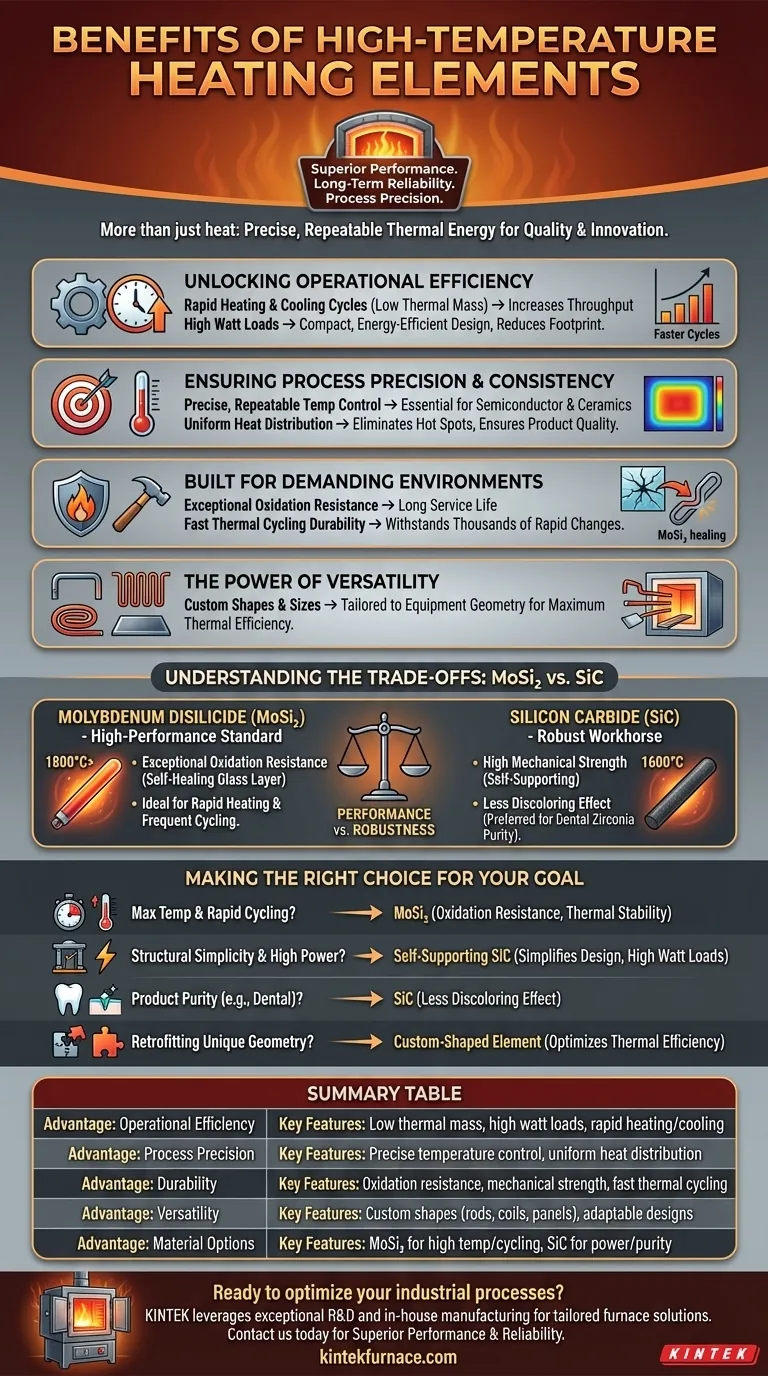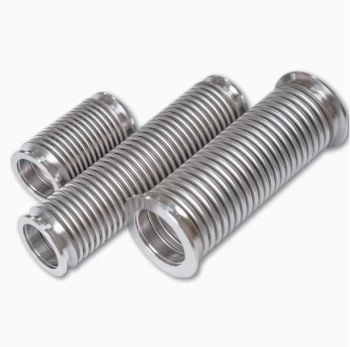In any industrial process, the choice of heating element is a critical decision that directly impacts operational outcomes. The primary benefits of high-temperature heating elements are a combination of superior performance, long-term reliability, and process precision. They enable faster, more consistent production cycles while withstanding the harshest industrial environments, ultimately reducing downtime and lowering total cost of ownership.
The core value of a high-temperature heating element isn't just its ability to get hot. It is its capacity to deliver precise, repeatable thermal energy efficiently, which unlocks higher product quality, increased throughput, and greater innovation in manufacturing processes.
The Core Advantages Explained
High-temperature heating elements are not commodities; they are engineered components designed to solve specific thermal challenges. Their benefits extend far beyond simple heat generation.
Unlocking Operational Efficiency
A key advantage is the ability to improve the overall efficiency of an industrial process. This is achieved through several key characteristics.
Modern elements often feature a low thermal mass, allowing for rapid heating and cooling cycles. This reduces wait times between batches and significantly increases throughput.
Materials like silicon carbide can handle high watt loads, meaning more power can be concentrated in a smaller area. This allows for more compact and energy-efficient furnace designs, reducing the factory footprint and operational energy costs.
Ensuring Process Precision and Consistency
The quality of a final product often depends on exact temperature control. High-temperature elements provide a level of precision that is essential for advanced manufacturing.
Their stable electrical resistance across a wide temperature range allows for precise and repeatable temperature control. This consistency is crucial in applications like semiconductor manufacturing or ceramics firing, where slight deviations can ruin a product.
Advanced elements deliver uniform heat distribution, eliminating hot spots and ensuring the entire workload is processed under the same thermal conditions, which is vital for product quality.
Built for Demanding Environments
Industrial furnaces and kilns are unforgiving environments. These elements are specifically engineered for durability and a long service life.
Materials are selected for exceptional oxidation resistance and mechanical strength at extreme temperatures. This prevents degradation and premature failure.
Elements like Molybdenum Disilicide (MoSi₂) are particularly adept at withstanding fast thermal cycling. This means they can be heated and cooled rapidly thousands of times without physical or chemical breakdown.
The Power of Versatility
There is no one-size-fits-all heating solution. The ability to customize elements is a significant advantage that allows for process optimization.
High-temperature heating elements are available in a vast array of shapes and sizes, including straight or bent rods, coils, and flat panels. This flexibility allows engineers to design heating systems that perfectly match the geometry of their equipment for maximum thermal efficiency.
Understanding the Trade-offs: MoSi₂ vs. SiC
Choosing the right material is a critical engineering decision that involves balancing performance characteristics. Molybdenum Disilicide (MoSi₂) and Silicon Carbide (SiC) are two of the most common materials, each with distinct advantages.
Molybdenum Disilicide (MoSi₂): The High-Performance Standard
MoSi₂ elements are renowned for their ability to perform at very high temperatures, often exceeding 1800°C.
Their primary strength is an exceptional resistance to oxidation. At high temperatures, they form a protective layer of silica glass that "heals" itself, granting them a very long service life in oxidizing atmospheres. They are ideal for processes requiring rapid heating and frequent cycling.
Silicon Carbide (SiC): The Robust Workhorse
SiC elements are known for their durability and high power capabilities, operating effectively up to 1600°C.
A key advantage of SiC is its high mechanical strength, which allows many element designs to be self-supporting. This simplifies furnace construction by eliminating the need for complex and costly support structures.
In certain applications, such as the firing of dental zirconia, SiC is preferred because it has less discoloring effect on the final product compared to MoSi₂. This makes it the superior choice when product aesthetics and purity are paramount.
Making the Right Choice for Your Goal
Your application's specific demands should dictate your choice of heating element. The optimal solution is the one that best aligns with your primary operational objective.
- If your primary focus is maximum temperature and rapid cycling: MoSi₂ elements are often the superior choice due to their exceptional oxidation resistance and thermal stability.
- If your primary focus is structural simplicity and high power density: Self-supporting SiC elements can simplify furnace design and handle high watt loads effectively.
- If your primary focus is product purity in specific applications (e.g., dental ceramics): SiC may be preferred as it has less discoloring effect on materials like zirconia compared to MoSi₂.
- If your primary focus is retrofitting a unique geometry: A custom-shaped element provides the flexibility to optimize thermal efficiency for your specific equipment.
By understanding these core principles, you can select a heating element that doesn't just generate heat, but drives process innovation and operational excellence.
Summary Table:
| Advantage | Key Features |
|---|---|
| Operational Efficiency | Low thermal mass, high watt loads, rapid heating/cooling |
| Process Precision | Precise temperature control, uniform heat distribution |
| Durability | Oxidation resistance, mechanical strength, fast thermal cycling |
| Versatility | Custom shapes (rods, coils, panels), adaptable designs |
| Material Options | MoSi₂ for high temp/cycling, SiC for power/purity |
Ready to optimize your industrial processes with advanced high-temperature heating solutions? At KINTEK, we leverage exceptional R&D and in-house manufacturing to provide diverse laboratories and industries with tailored furnace solutions, including Muffle, Tube, Rotary Furnaces, Vacuum & Atmosphere Furnaces, and CVD/PECVD Systems. Our strong deep customization capability ensures we precisely meet your unique experimental and production needs, delivering superior performance, reliability, and cost savings. Contact us today to discuss how we can enhance your operations!
Visual Guide

Related Products
- Silicon Carbide SiC Thermal Heating Elements for Electric Furnace
- Laboratory Muffle Oven Furnace with Bottom Lifting
- Vacuum Heat Treat Furnace with Ceramic Fiber Liner
- 1800℃ High Temperature Muffle Oven Furnace for Laboratory
- Split Multi Heating Zone Rotary Tube Furnace Rotating Tube Furnace
People Also Ask
- What are the operational characteristics of SiC heating elements? Maximize High-Temp Performance and Efficiency
- What types of heating elements are commonly used in drop tube furnaces? Find the Right Element for Your Temperature Needs
- What is silicon carbide used for in heating applications? Discover Its High-Temperature Durability
- What heating elements are used in high-temperature tube furnaces? Discover SiC and MoSi2 for Extreme Heat
- What parameters does the IEC standard specify for heating elements? Ensure Safety and Performance



















